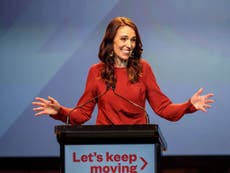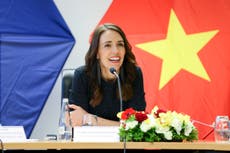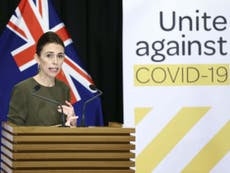Jacinda Ardern: A beacon of hope in our tumultuous times
It’s hard to imagine a more turbulent three years in New Zealand’s recent history, but Jacinda Ardern’s impressive handling of successive crises and her positive leadership style has seen her become one the world’s most prominent leaders. As she wins an historic landslide, Sean O’Grady looks at her tenure so far


New Zealand is a nation of 4.9 million people, 27 million sheep – and one global superstar. Jacinda Ardern, who has served as prime minister only since 2017, has certainly made her mark on the world stage. Now, as she wins her second term as prime minister for her Labour Party, with an historically impressive margin over her National Party (Conservative) rivals she will be free to set her country on her own radical course. Indeed, in two (non-binding) referendums held on the same day as the general election, New Zealand seems set to decriminalise cannabis and legalise euthanasia. Ardern is not only the youngest female leader in the world and only the second to give birth while holding such a job down, but the head of the world’s first woke administration, at least in an advanced economy.
Ardern was, after all, featured on a Vogue cover as “The Anti-Trump”, and she has become an icon for progressives, liberals and woke folk everywhere. Others have fallen away. Unlike Justin Trudeau in Canada, she has never been caught in black face; unlike Hugo Chavez and Nicolas Maduro she’s not bankrupted her country; and unlike Jeremy Corbyn she’s actually good at winning elections. She is busily building the world’s first Scandinavian state in the Southern Hemisphere. It is a great adventure, and that well suits Ardern’s boundless optimism, informal style and trademark high energy grin.
Perhaps the most remarkable compliment paid to Ardern, at least from a British perspective, is that she has her very own Spitting Image puppet, further proof of her projection on to the world stage. A recent musical sequence has her portrayed as a modern day Mary Poppins, dispensing good will and slightly bossy, mumsy advice to her happy people, knocking coronavirus out of the park end creating a new supercalifragilisticexpialidocious country – a Superkiwisocialisticempireofjacinda in the playful lyrics. It was an accurate enough image of the ultimate nanny of the nanny state.
The Ardern puppet also appears with the likes of Trump, Xi, Modi and Merkel in a mock UN assembly. Again, latex lampoonery echoes the real world. When Ardern turned up to the real UN assembly she brought her first born, baby Neve with her, another Ardern global first.
She has enjoyed an astonishing rise. She was fortunate that her Labour Party was lumbered with a series of lacklustre leaders until it finally turned for salvation to Ardern in 2017. She’d served as deputy leader for a couple of months and had been an MP for only nine years. She’d never run anything, and was basically an assistant to, and protege of, the highly successful Helen Clark, who served three terms as premier (1999 to 2008).
She and Clark were and are devoted to one another. There is a revealing story that Ardern tells, about when it looked as if Clark had lost the 2005 general election: “I remember my dad calling me and saying ‘don’t worry, you’ll be able to find another job’ because he knew how upset I was. And I remember saying in this broken voice ‘it’s not about my job’. What about all the people who’ll have to pay market rents in their houses?’” She happily agrees that she really is a “do gooder”.
Her only other remotely high-level political activity had been a spell in a junior role in the British cabinet office at the tail end of Tony Blair’s premiership, an unusual variation on the usual rite of passage of a young wandering kiwi. Before hanging out in Downing Street she’d been volunteering at a soup kitchen in New York.
In her first message to her party she announced that hers and her campaign’s theme would be “relentless positivity”, and it worked. It is, by the way, in stark contrast to the habitual miserabilism that usually turns British voters off the British Labour Party. Maybe Ardern learned the value of a toothy smile and an upbeat demeanour from her exposure to Blair (though obviously she despises his war in Iraq). In fact, though to the left of Blair, Ardern’s socialism is also distinctly pragmatic. She evinces little interest in theory, and her role model, apart from Clark, is Norm Kirk, an inspirational and charismatic Labour leader and PM before his premature death in 1974.
Elected unopposed as Labour leader in 2017 (“as if anointing a prophet” as one commentator put it), then thrown into a general election only a few weeks later, she managed to secure a decent result for her party, though the ruling Nationals in fact won more votes and seats. “Jacinderella” arrived and “Jacintime” was the quip of the day. Through a mix of charm and political expediency, Ardern managed to form an improbable coalition government with the maverick populist New Zealand First party, a Farageist grouping, while simultaneously maintaining the support of the Greens. At 37 she was premier.
In normal times, Ardern’s subsequent record might not have been sufficient to reward her with a second term in New Zealand’s short, three-year, electoral cycle. She promised to build more houses, end homelessness, reduce child poverty and introduce a capital gains tax. Little of that agenda became reality: her success and the international respect she has garnered has been much more to do with her response to events far outside the normal run of party or class politics.
She is busily building the world’s first Scandinavian state in the Southern Hemisphere. It is a great adventure, and that well suits Ardern’s boundless optimism, informal style and trademark high energy grin
The terror attack on two mosques in Christchurch by an armed extremist in March 2019 commanded global attention, with 51 innocents left murdered. Rather than exploit the event to pursue some sort of contrived culture war, Ardern instead donned a headscarf, put an arm around bereaved mothers and declared with a plain eloquence of Muslim New Zealanders: “They are us”. The nation stood in dignity against depravity. As a lasting achievement she made most assault weapons illegal, another example to the gun-toting nations of the world.
Ardern displayed the same sure touch for the public mood in December, after a volcano erupted on an offshore island and took the lives of 21 tourists.
Covid, though, and New Zealand’s response to it, was what laid the foundation for Ardern’s election success and her high global profile. It is true that New Zealand has some natural advantages during a pandemic. It’s an island state, more or less self sufficient, mostly sparsely populated and relatively prosperous. Then again, there is nothing inevitable or easy about almost eliminating a highly contagious micro-organism from your shores, and that is exactly what Ardern and her “five million strong team of New Zealanders” have managed to do. “Let’s Get This Done” is one of her slogans, and on Covid she and her country have more to show, and proportionately far fewer deaths, than more powerful nations. At 25, the total death toll would equate to a figure of 300 deaths for the UK, against an actual number of 43,000. That’s a Jacinda effect any country would be grateful for. For a time New Zealand was declared Covid-free, and remains pretty much there, a model of good governance and collective spirit, which you might call socialism, kiwi style.
That special political style is maybe natural, maybe curated, but it is effective. Even now, with a security detail, she likes to drive herself around and go shopping and do “ordinary things”. There are videos on her Twitter feed of her opening secret Santa gifts and there’s a video explaining to bewildered New Zealand kids that the Easter Bunny and the tooth fairy are officially deemed “essential workers”. She enjoys a whiskey, she admits to toking on a joint “a long time ago”, she can do a stint as a part time DJ (Sid Vicious, Snoop Dogg, Smashing Pumpkins), and is an aficionado of New Zealand drum and bass, Concord Dawn being a favourite (not to be mixed up with Flight of the Conchords). She was proud of her “different” late cat, Paddles, who had polydactylism – extra toes.
Ardern, hero of the global left, is still very much the small town girl from Morrinsville, daughter of a cop, and lapsed Mormon, now agnostic (because of the homophobia). Her long term partner, Clarke Gayford, is a TV presenter, and neither they nor her voters seem bothered about the lack of wedding rings (she and Gayford are engaged though). She is extraordinarily ordinary, mixing the domestic and the geopolitical, getting the work-life balance right – the kind of prime minister mumsnet would create if Ardern had not been invented.
Yet, for all the Jacindamania, she has her flaws. In the debates with her National Party rival, Judith “Crusher” Collins, Ardern sometimes came across as vague and platitudinous (though the calm confrontations between the two women were an educative contrast to the Biden-Trump confrontation). She refuses to say whether she’s in favour of decriminalising cannabis, and fudges the question of New Zealand ditching the monarchy – she is not as candid as she likes to appear. Like every other Australasian mainstream politician she feels unabashed about a basically anti-immigrant and/or anti-refugee stance, though hers is softer than most and offered to take some of the many dumped by Australia in appalling conditions in camps in Papua New Guinea. She’s also had her tiffs with Australia about the Aussies’ habit of deporting New Zealanders of colour.
Ardern could also be faulted for pulling her punches a bit. Asked, for example, whether she thought Donald Trump might be a bit of a sexist, she replied: “Hmmnnn. I think probably everyone will have their own perspective. I know what I feel comfortable with and so when that comes to the way we portray women for me it’s how I would like to be treated and talked about, how would I like my mother to be treated and talked about. That’s the lens I apply. Can’t change the way anyone else behaves though.”
Depending for survival on coalition partners for the past three years, and in the midst of a pandemic, Jacindaland is an unfinished project, and the economy is suffering from the knock to tourism. As with plenty of others, New Zealand also finds China’s wealth and power a double-edged sword, and as a member of the five eyes intelligence network, with America, Canada, Australia and Britain, the Huawei dilemma faced Ardern too.
But now she is in for three years, has pushed the right aside and has the world, or at least New Zealand, at her feet. She can either “do this thing”, rehabilitate liberal values and pioneer the long fight back against nationalism and populism; or she can fail. In the 1930s, when New Zealand created an early welfare state and in the 1980s and 1990s when it dismantled it, the nation was the setting for bold social experimentation. If all goes well, the world will once again be watching and wondering at Jacinda’s New Zealand, and not just for those lovely, majestic backdrops to the Lord of the Rings movies.





Join our commenting forum
Join thought-provoking conversations, follow other Independent readers and see their replies
Comments